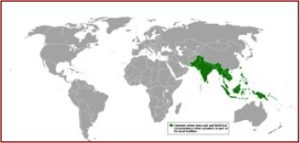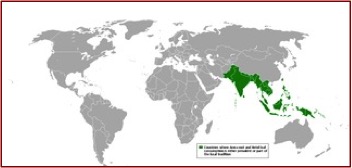
Police in Reynoldsburg Ohio, a suburban community in the Columbus Ohio metropolitan area, were called to the local high school when some students were acting dazed and disoriented. This kind of news is not unusual these days, but what they were using was—betel nut. Several news outlets picked up the story, including The News Herald, the CBS affiliate Cleveland 19, and The Fix. Although betel nut or areca nut is not well known in the U.S., it is the fourth most commonly used “social” drug worldwide, after nicotine, ethanol, and caffeine. Over 600 million people—10 percent of the world’s population—presently use some form of areca/betel nut.
Technically the areca nut is the seed of the areca palm, which grows in the tropical Pacific, parts of Africa, Southeast and South Asia. It’s not a true nut, but rather a berry. It is commercially available in dried, cured and fresh forms. Usually chewed, a few slices of areca nut are wrapped in a betel leaf containing calcium hydroxide (slaked lime) and mixed with clove, cinnamon or other spices. It gives the users a warming sensation and a heightened sense of alertness, but the effects vary from person to person. A BBC news report said it gives a buzz equivalent to about six cups of coffee.
Its use dates back thousands of years in the above noted areas of Asia and the Pacific. It isn’t known how or when the psychoactive properties of combining the areca nut and the betel leaf were discovered. However, archaeological evidence in Thailand, Indonesia and the Philippines suggests they have been used together for at least 4,000 years. A Report by the World Health Organization (WHO) noted there is evidence of betel nut use in Guam and the Northern Mariana Islands for 2,000 years and the Solomon Islands for at least 1,000 years.
There is a Vietnamese myth about the betel leaf and areca nut that goes like this. There were twin brothers, Tan and Lang who were benig tutored by a Taoist named Chu Chu. The tutor had a beautiful daughter, who he gave in marriage to Tan. The two of them were very happy together. But Tan grew apart from Lang after he was married. So Lang decided to go away and wander around the country.
Finally he reached a large river, but could not cross it. There was no boat to transfer him to the other side. Lang was so sad that he kept crying until he died. Then he was transformed into a lime-stone by the river. Troubled by Lang’s absence, Tan went looking for him. When he reached the river, Tan sat on the lime-stone and died from exhaustion and weariness. “He was transformed into an areca tree.” The young woman in turn went looking for her husband when he did not return. When she reached the place where the areca tree grew, she leaned against the tree and died. And she was transformed into the betel vine.
The local inhabitants set up a temple to their memory, commemorating this tragic love story. One day, King Hung went to the temple and heard this tragic love story. He ordered his men to ground together a leaf of betel, an areca nut and a piece of lime. A juice, as red as human blood, was formed out of the mixture. He tasted it, found that it was delicious, Then the king recommended the mixture be used at every marriage ceremony from then on.
The leaves and juices are used in Vietnamese weddings, symbolizing the idealized married couple. Guests to a Malay house are offered a try of areca nuts and betel leaves like drinks are offered in other cultures. See the following link for more information on the variety of cultures using the areca nut.
 So what’s not to like? WebMD reported that eating 8 to 30 grams of betel nut could cause death. Your mouth, lips and stool can turn red. It can cause diarrhea, vomiting, gum problems, chest pain, abnormal heartbeats, low blood pressure, shortness of breath, rapid breathing, heart attack and coma. Interactions with some medications can be problematic, decreasing the effectiveness of antidepressants and antihistamines. It can interact with medications used for glaucoma and Alzheimer’s disease. “Stay on the safe side and avoid using betel nut if you are pregnant or breast-feeding.”
So what’s not to like? WebMD reported that eating 8 to 30 grams of betel nut could cause death. Your mouth, lips and stool can turn red. It can cause diarrhea, vomiting, gum problems, chest pain, abnormal heartbeats, low blood pressure, shortness of breath, rapid breathing, heart attack and coma. Interactions with some medications can be problematic, decreasing the effectiveness of antidepressants and antihistamines. It can interact with medications used for glaucoma and Alzheimer’s disease. “Stay on the safe side and avoid using betel nut if you are pregnant or breast-feeding.”
Gang et al. did a systematic review of the adverse effects of betel nut. The authors said it affects almost all the organs of the human body, “including the brain, heart, lungs, gastrointestinal tract and reproductive organs.” It causes or aggravates several medical conditions including asthma, type II diabetes, infertility, and heart problems such as myocardial infarction and cardiac arrhythmias. It affects the immune system leading to suppression of T-cell activity and decreased release of cytokines. See the following link to Table 1 in the article for a summary of the systematic effects. “Thus, areca nut is not a harmless substance as often perceived and proclaimed by the manufacturers of areca nut products such as Pan Masala, Supari Mix, Betel quid, etc.”
The effects of areca nut are mainly on the central and autonomic nervous systems from the alkaloid arecoline. There is a dependency syndrome associated with the use of areca nut that includes increased concentration, mild euphoria, relaxation and withdrawal. The withdrawal syndrome is associated with insomnia, mood swings, irritability and anxiety. The severity is comparable to that of amphetamine use. “Areca nut leads to palpitation, increased blood pressure, increased body temperature, flushing and sweating within minutes of consumption.” And there is substantial evidence that it is a carcinogen, contributing to cancers of the mouth, esophagus, liver and uterus.
A 2010 study by Bhat et al. looked specifically at areca nut dependency among a South Indian community. Fifty-nine daily chewers from Karanatka State in southwest India were surveyed. Questionnaires assessed their chewing history, pattern of use and adapted measures developed for assessing nicotine/tobacco dependence to assess areca dependence. There were low levels of dependency observed, but about 44% of chewers endorsed at least one of the following items: continued use despite illness or wounds, difficulty refraining from chewing in forbidden places, or craving during periods of abstinence.
At least 15% of respondents had intentionally made a quit attempt [ an attempt to quit]. During periods of abstinence for any reason, 27% reported feelings of discomfort or craving. Many of these participants were those who scored high on the dependence measures and/or reported a high frequency of use. Of the 13 informants who reported the highest number of nuts chewed/day (i.e., 5), nine had scores ≥ 16 on the CDS-5. These individuals also reported the greatest number of use episodes/day, with 6–15 chews daily.
Many chewers started as adolescents of young adults; 52.5% started before the age of 30. Reasons for starting to chew areca nut included boredom (39.0%) and as an aid in socialization (28.8%). Many respondents also said it helped them at work. “Chewing helps me to think what to do next, or how to do other work.” They also reported using areca nut as a mouth and breath freshener.
 At this point in time, betel/areca nut use is not a drug of concern outside of the Western Pacific Region, highlighted in the above graphic. In the US, betel nut is not a controlled substance and can even be found in some Asian grocery stores. The Reynoldsburg Police Chief, Jim O’Neill, said they would like to keep this out of the hands of students, which may be difficult. Although it’s illegal to import, betel nut is readily available online—“a loophole law enforcement agencies want to see shut.” Health inspectors in Ohio are searching markets to remove betel nuts from shelves; and the FDA was said to be investigating into betel nut use.
At this point in time, betel/areca nut use is not a drug of concern outside of the Western Pacific Region, highlighted in the above graphic. In the US, betel nut is not a controlled substance and can even be found in some Asian grocery stores. The Reynoldsburg Police Chief, Jim O’Neill, said they would like to keep this out of the hands of students, which may be difficult. Although it’s illegal to import, betel nut is readily available online—“a loophole law enforcement agencies want to see shut.” Health inspectors in Ohio are searching markets to remove betel nuts from shelves; and the FDA was said to be investigating into betel nut use.
In writing this article, particularly in light of the Vietnamese legend described above, I thought of the bridal rhyme that goes “Something old, something new, something borrowed, something blue.” Well, at least the first half of it. Betel nut use has an old, long history; and yet, is being investigated as a new, potentially harmful substance by the FDA. It seems that betel nut use and misuse is something old that became something new in the ongoing American cultural wars against mind altering-mood changing substances.





